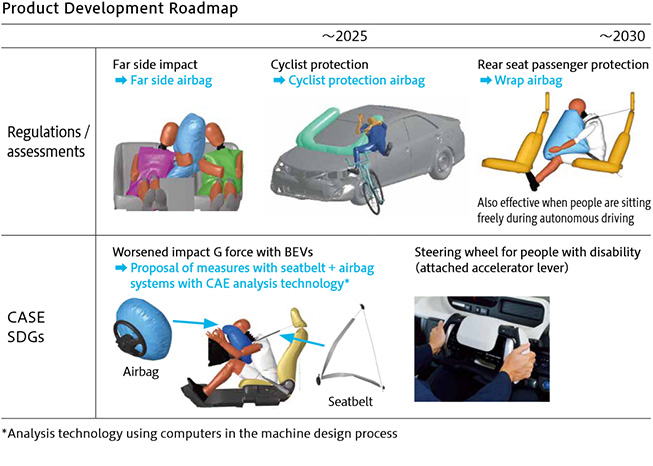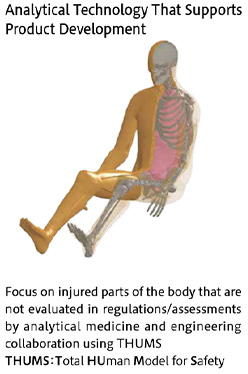Reducing the number of traffic fatalities
- HOME
- Areas of focus
- Reducing the number of traffic fatalities
Although rapid advances are being made in automobile safety performance, traffic fatalities are on the rise in regions where the development of traffic infrastructure lags behind the widespread use of automobiles and safety equipment such as airbags are not widely used. Even in developed countries with well-developed transportation infrastructure and widespread safety equipment, the number of traffic fatalities is far from negligible. In recent years, global traffic fatalities have hovered around 1.35 million. To contribute to traffic safety and security, we will continue to pursue higher-performance safety equipment and provide this equipment in many regions.
01Wider Use of Airbags Will Bring Us Closer to Zero Traffic Fatalities
The World Health Organization (WHO) reports that in recent years the number of traffic fatalities worldwide has trended at around 1.35 million annually. It is estimated that between 2020 and 2030, the total number of traffic fatalities will be approximately 13 million. One of the reasons for these high numbers, along with the lagging state of transportation infrastructure and the high ratio of two-wheeled vehicles, especially in developing countries, is thought to be that automobile airbags and other safety equipment have not been widely adopted. In India, Southeast Asia, and other regions where there is large growth in the automobile market, demand for airbags will increase as regulations make airbags mandatory and initiatives advance to raise airbag adoption rates by strengthening assessments.
While the number of traffic fatalities is gradually decreasing in western countries, Japan, and elsewhere, many issues still need to be resolved before the number of fatalities can be brought closer to zero. Through the continuous evolution of airbags and other safety equipment, we want to increase the types of accident in which people can be saved. In addition, safety systems of vehicles in the coming years need to evolve to accommodate changes.
New vehicles such as BEVs and micro-vehicles are appearing on the market, and these vehicles differ from conventional vehicles in the degree of impact on occupants and vehicle body deformation in the event of an accident. At the same time, advances in autonomous driving technology are expected to allow drivers more freedom in their actions and riding posture.
In response to these market trends and changes in the environment, we have established two major growth strategies for the Safety System business.
-
1.Increase Production Capacity
We will increase production capacity in regions with rising demand for airbags
-
2.Further Evolve Safety Systems
We will improve the performance of airbags to cover injuries that conventional airbags do not protect against
We will also develop technologies and products to respond to changes in the environment
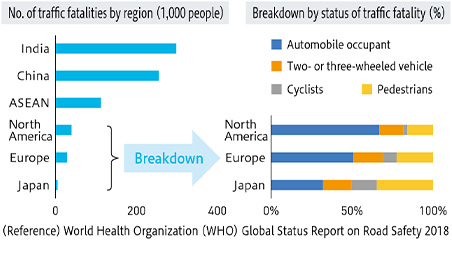
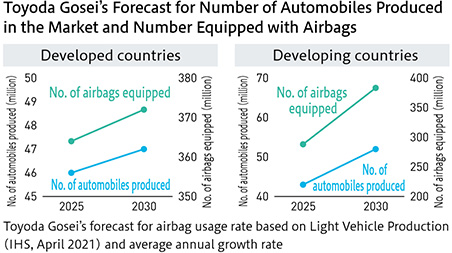
02Increase Production Capacity
We are increasing our production capacity in China, India, and Southeast Asia to keep pace with the rising number of airbags that will be installed in vehicles after 2025. In China, we established a new plant in the southern part of the country (to start operations in summer 2023). It will be the first SS plant to incorporate the “TG Advanced Plant Concept,” pursuing efficient manufacturing and utilizing IoT and AI to monitor production status in real time from anywhere.
In addition, we will promote jidoka (autonomation) to ensure sufficient production capacity to meet increasing demand.
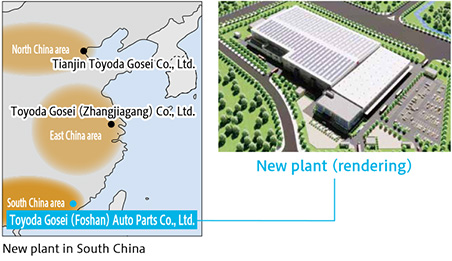
03Further Evolve Safety Systems
Overall, the number of traffic fatalities in developed countries has been on the decline. One factor is the evolution of safer vehicle bodies in collisions and safety equipment such as airbags. Automatic braking and driving are also expected to evolve in the future, ushering in an era in which many accidents themselves can be prevented. However, more time is said to be needed. Therefore, the continuous evolution of airbags and other safety equipment that protect passengers and pedestrians in the event of a traffic accident is still needed.
In 2020, we began mass production of far-side airbags that prevent injury to occupants thrown to the opposite side of the vehicle during side impact collisions. We have continued developing these airbags since then, earning high praise from many automakers. Our most recent far-side airbag is also compliant with the new, stricterassessments.
With the BEVs that will become mainstream in the future, impacts on occupants during traffic accidents may be more severe in some cases due to changes in the vehicle body structure. This will require safety equipment with high levels of impact absorption.
Airbags and other safety equipment must also evolve to match the advanced design and changes in riding posture that are expected in the future.
Computer analysis is one of our strengths as a technology that supports such development. Various vehicles and the human body reproduced on computers are used to simulate accidents. This allows us to predict how vehicles will be damaged and the types of injuries that will be sustained by humans. This is then fed back into the development of new products. We also have connections with medical institutions and universities to improve reproductions of the tolerance of the human body and increase the accuracy of our analysis.
This technology makes it possible to analyze the entire vehicle as a system, rather than just the airbag itself, and to propose improved protection performance that also combines the vehicle body and seat belts. We are also addressing social issues, such as the development of a steering wheel with an accelerator lever for drivers with lower limb disabilities. This makes it possible to accelerate the vehicle with the steering wheel alone.
